Table of contents
- Version documentalist
- Version realisation
- Upgrade Motivation
- Detailed staff
- Electronic equipment list
- Work related information
- Useful links on Brahms
- Instructions
- Audio setup
- Loudspeaker setup
- Midi setup
- Software installation
- Initialization routine
- Concert patch presentation and calibration
- Antescofo calibration
- Simulation system
- DSP engine and Spatialization
- Diagram of internal system of treatments in the “Einspielung-I-“ Max patch.
- Different shapes of envelopes used in Einspielung-I:
- Performance notes
- Program note
Performance date: 6 mars 2019
Documentation date: 9 juin 2021
Version state
Valid
Validation date: 13 octobre 2021
Executions dates of this version
- 6 mars 2019,
Version documentalist
- svidzinski (Joao.Svidzinski@ircam.fr)
Version realisation
- José Miguel Fernandez (Computer Music Designer)
- David Poissonnier (Computer Music Designer)
Version length
17 mn 46 sUpgrade Motivation
2021 port (Max8 64bit with 48Khz SR) of the original version .
Other version(s)
- Emmanuel Nunes - Einspielung I - 2023-ESPRO
- Emmanuel Nunes - Einspielung I - Manifeste 2021 - 8 speakers
- Emmanuel Nunes - Einspielung I - 2019 Eastman
- Emmanuel Nunes - Einspielung I - Geneve2014
- Emmanuel Nunes - Einspielung I - Documentation Einspielung I
- Emmanuel Nunes - Einspielung I - creation-agora-2011
Detailed staff
- violon
Channel details
- Number of input channel : 1
- Number of output channel : 11
Electronic equipment list
Computer Music Equipment
-
1 Max 8 - Max
(Cycling74)
-
1 antescofo~ - External objects
(Ircam)
version 1.0-1 -
1 Sound Board - Sound Board
(RME Fireface 800) -
1 BCF 2000 - MIDI Mixer
(Behringer)
Audio Equipment
-
1 DPA 4061 - Condenser Microphones
(DPA)
-
11 Loudspeaker - Loudspeakers
-
1 subwoofer - Subwoofers
-
1 Mixing Console - Mixing Console
with 13 Out and 1 Input, with 1 slot ADAT for connect to Audio Interface
Work related information
Premiere
- 16 juin 2011, France, Paris, Centre Pompidou, festival Agora
Publisher :
- Jobert
Realisation
- José-Miguel Fernandez
Work length
- 17 mn
Useful links on Brahms
- Einspielung I seconde version, pour violon et électronique live (2011), 17mn
- Emmanuel Nunes
| File | Author(s) | Comment | |
|---|---|---|---|
| Download [247,4 Mio] | Patch EINSPIELUNG- 2021 | ||
| Download [608,5 Kio] | Score Score-RIM.pdf | José Miguel Fernandez | Score for computer music designer |
Instructions
Audio setup
• 11 points of diffusion (Speakers), see the diagram
• 1 Mixer with 13 Out and 1 Input, with 1 slot ADAT for connect to Audio Interface
• 1 microphone DPA 4061
• 1 or 2 Subwoofer
• 1 Macintosh computer with Max software.
• 1 Audio Interfaces (RME Fireface 800)
• 1 Midi controller (bcf2000)
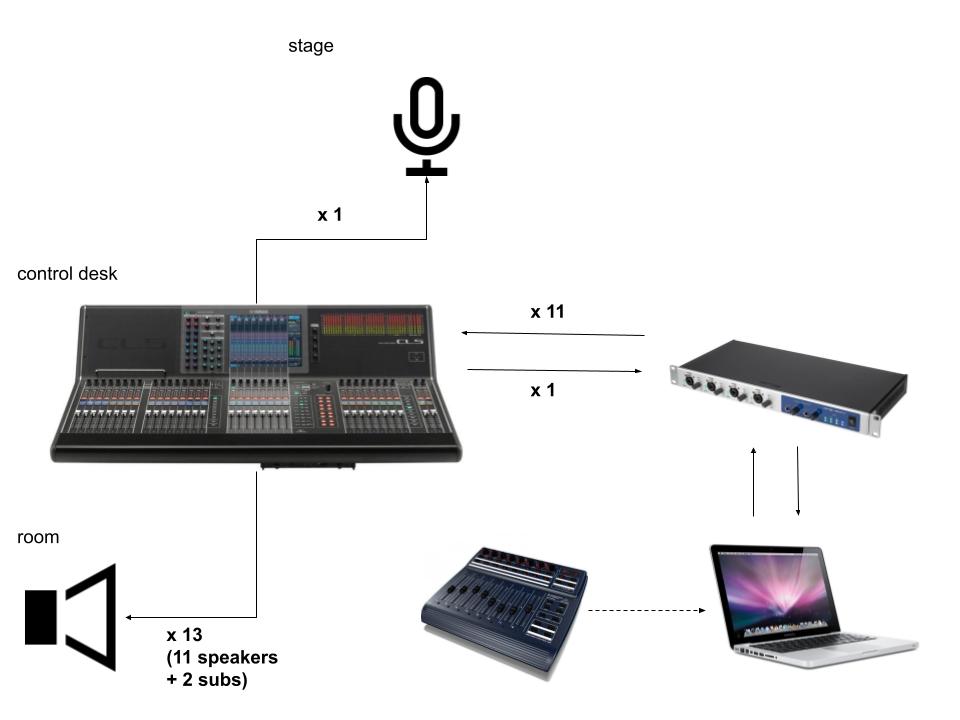
Loudspeaker setup
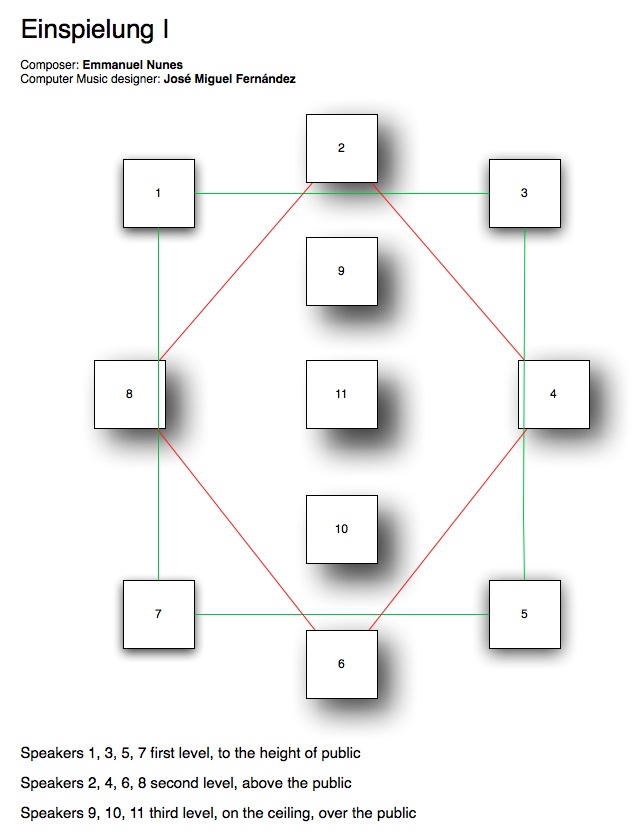
Midi setup
Use a BCF-2000 to control the treatments levels, the factorization of delay time and envelopes length.
Sliders:
- Control 1 [ctlin 7 1] = Direct sound level in dB
- Control 2 [ctlin 7 2] = Harmonizer level in dB
- Control 3 [ctlin 7 3] = Frequency Shifting level in dB
- Control 4 [ctlin 7 4] = Filters level in dB
- Control 5 [ctlin 7 5] = Resonators level in dB
- Control 6 [ctlin 7 6] = Reverberation level in dB
- Control 7 [ctlin 7 7] = Factorization envelopes length (1 normal length, 2 two times longer, 0.5 two times shorter)
- Control 8 [ctlin 7 8] = Violin input level in dB
Knob:
- Control 9 [ctlin 7 9] = Factorization delays length
Software installation
- Download Einspielung-2021.dmg.
- Mount the disk image and copy its contents in a folder named Einspielung-2021
- In Max 8, choose …/Einspielung-2021 in option > File preferences.
- Check the Audio status in option > Audio Status (see below).
- Close max and open _Einspielung-I-2021.maxpat (red label), in the Einspielung-I-Max folder, and Einspielung-Antescofo_concert_2021.maxpat (red label), in the Einspielung-I-Antescofo folder.

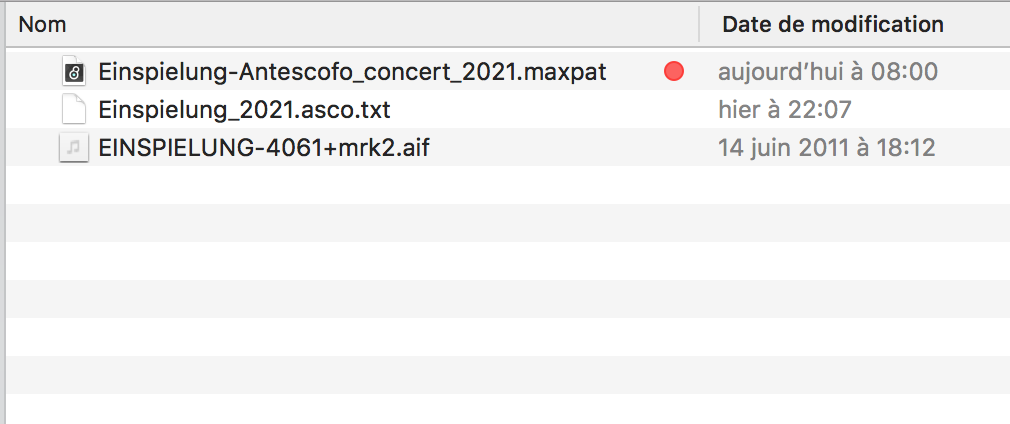
DSP status
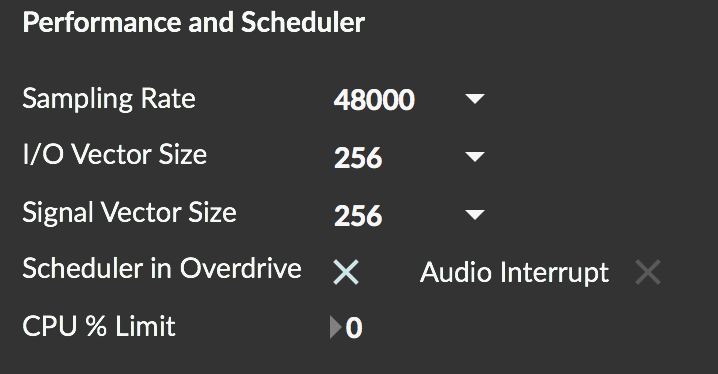
Initialization routine
Einspielung Irequires 2 Max patch to work :Einspielung-Antescofo_concert_2021.maxpatandEinspielung-Antescofo_concert_2021.maxpat
- Follow the Antescofo and concert patch routine (see below).
- Send the audio signal coming from the console (without any treatment or compression in direct out pre-fader) to both Max patches.
- Test the 11 outputs channels with the Audiotester patch (in the “Extra” Max menu).
- You need to try different parts of the score to adjust the input level of the violin to the “Einspielung-Antescofo” Max patch. Try for example the first page from measure 1 to 24, from measure 100 to 108, from measure 176 to 193.
Concert patch presentation and calibration

Follow the Initialization routine.
- Check the DSP status.
- Check the Midi controller input (Select the bcf2000 midi device in the menu).
- Initalize (reset and init buttons ).
- Turn on DSP.
- Adjust the midi faders : Typically start settings for treatments are: 0dB for “Vln” 0dB for “Direct”, -3dB for “Harmo”, -7dB for “Fshift”, -11dB for “Filter, -24dB for “Reson”, -15dB for “Rev”, 1.12 for “Del-fac” and 1.81 for “Fac”. Of course this parameters can be adjusted during the performance to have a “good mix” between the direct sound of violin and real time treatments.
- Set Fac and Del-Fac. Listen to the spatialisation. If the sound which goes from one to another HP is too long, decrease the Fac. However, if you have holes of sound when the sound goes from an HP to another, increase the factor.
- Initialize Antescofo Patch routine (see below).
The adc input is number 1 [adc~ 1], but you can easily change it by editing the patch.
Antescofo calibration
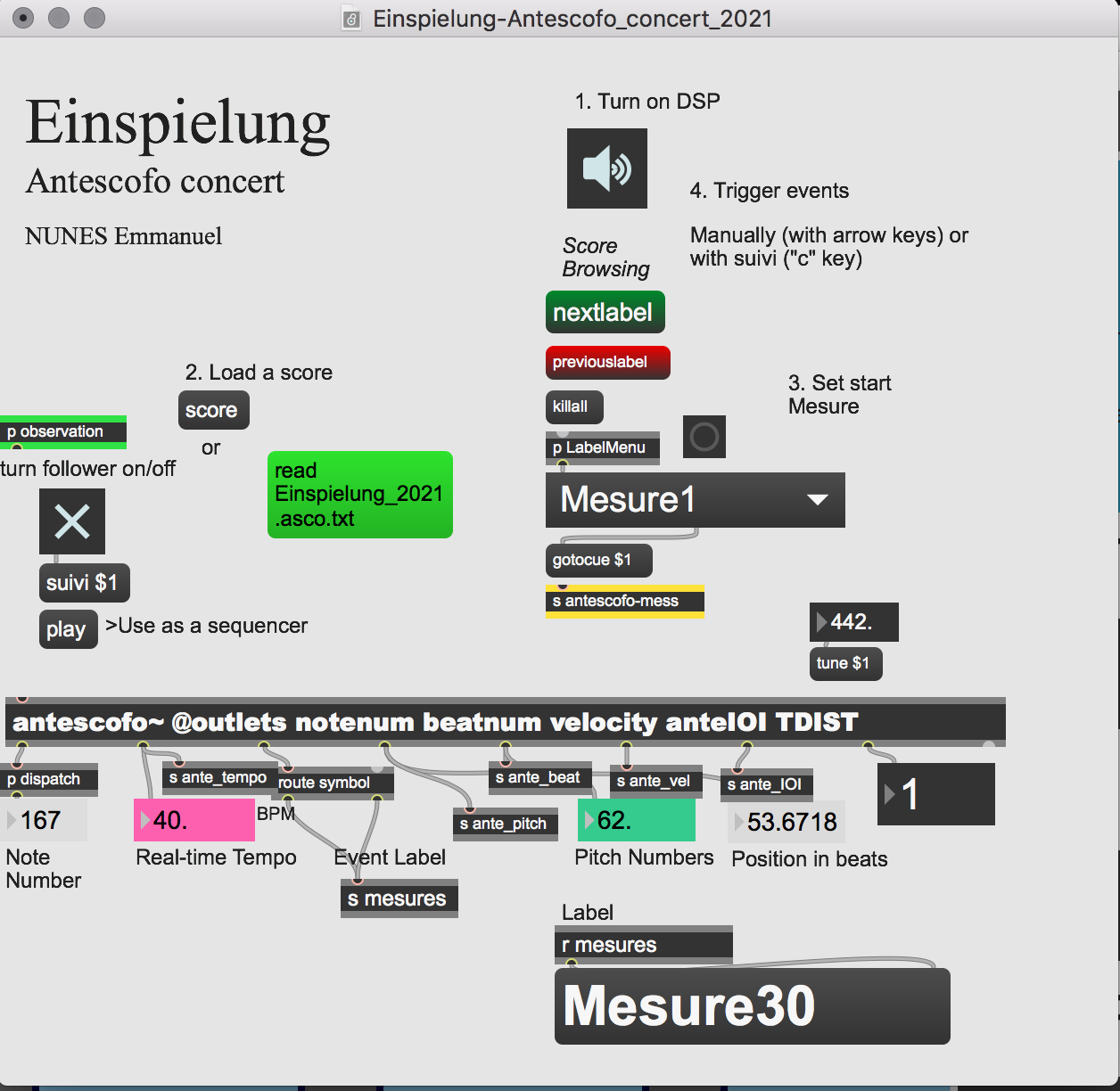
- First check the tuning of the instrument, usually 442 Hz.
- Check all the points as specified in the main patch:
- Press the green comment “read Einspielung_2021.aesco.txt” to load the antescofo score.
- Then select a “Mesure” in the umenu (Markers).
- With the key “c” you can activate or deactivate the score follower reflected by the toggle Max object.
- Use right arrow key to trigger the cues manually.
Simulation system
The simulation files could be used to test the setup before the rehearsal.
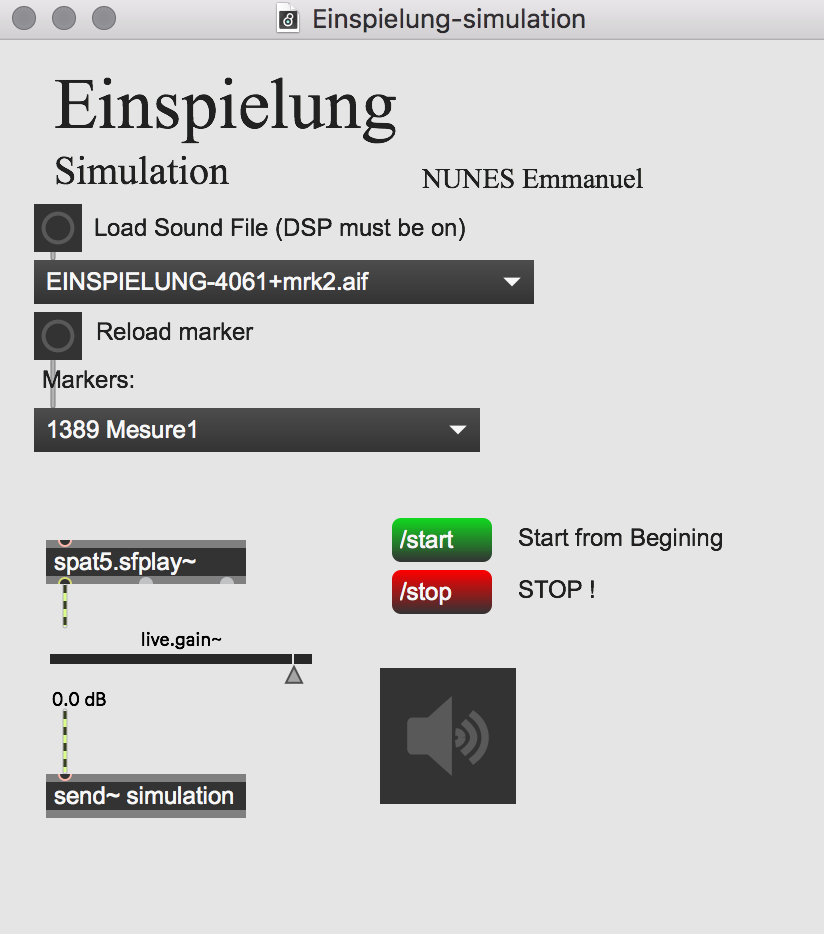
Open the Einspielung-simulation.maxpat, in the Einspielung-Simulation folder.
With the Einspielung-Antescofo_concert_2021.maxpat and _Einspielung_antescofo-I-2021.maxpat opened, start the simulation file. It is also possible to choose a different start point. In this case only modify the Markers selection and also modify it in the antescofo patch.
DSP engine and Spatialization
Diagram of internal system of treatments in the “Einspielung-I-“ Max patch.
There are 6 circuits of treatments (ADC-1 to 6), each one with treatments such as filters, harmonizers, Frequency Shifting, resonators, reverberations, delays and freezes that go directly to loudspeakers usually through an envelope.
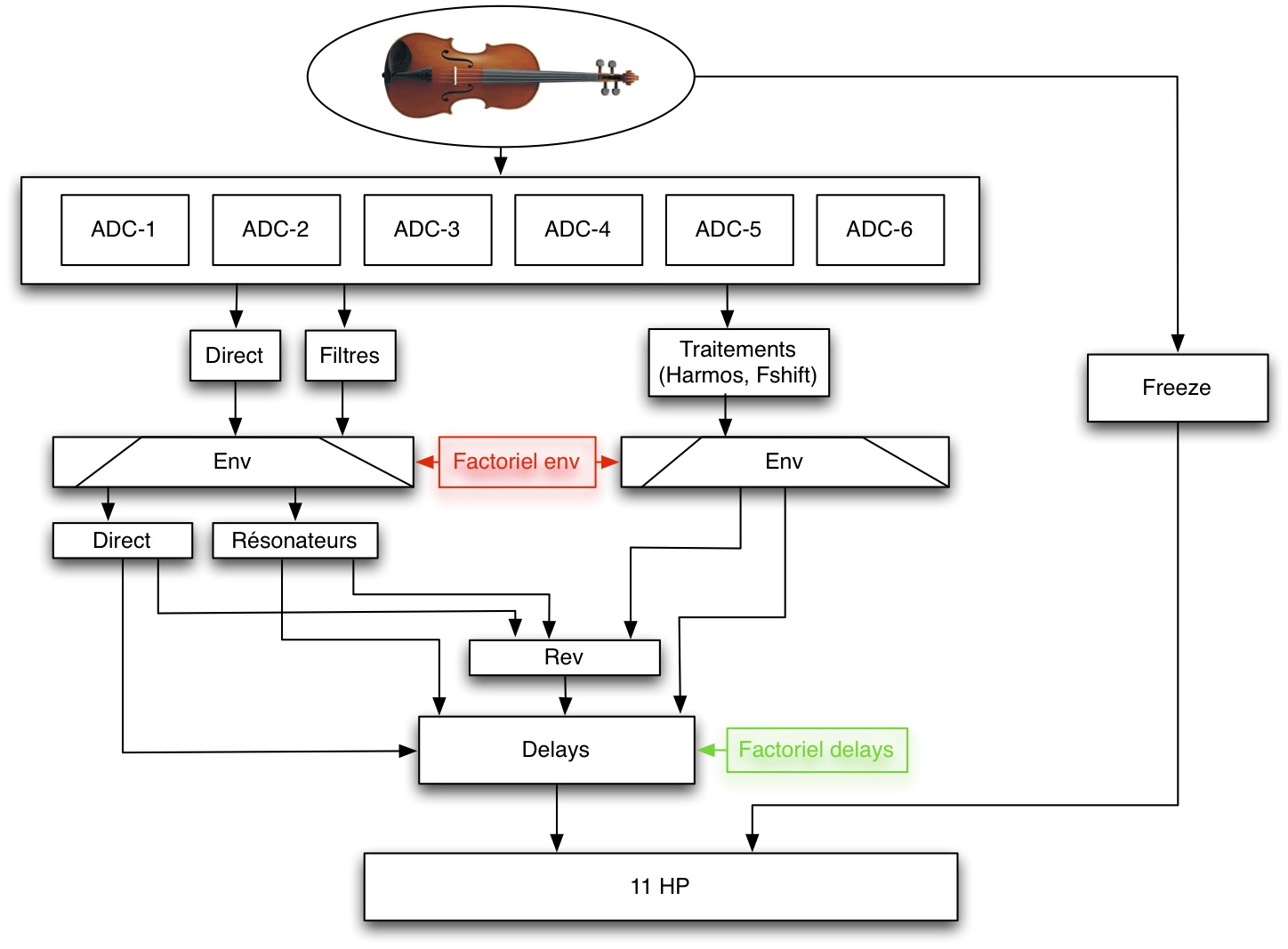
Different shapes of envelopes used in Einspielung-I:
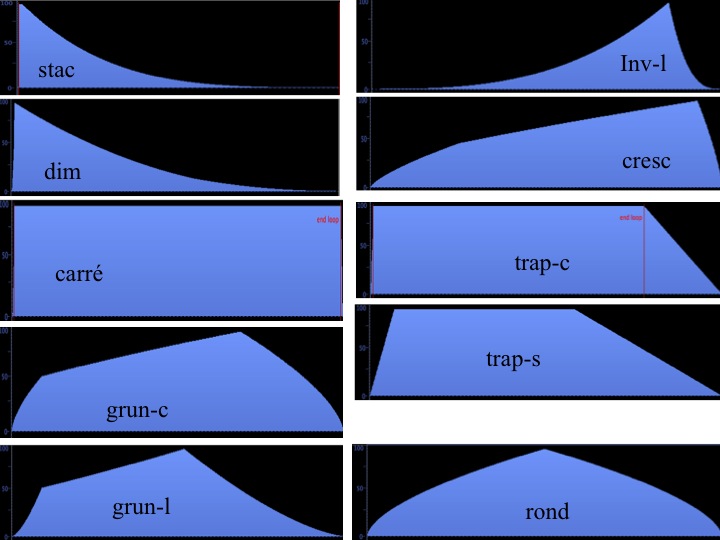
Performance notes
For the sound engineer: The violin must be amplified during the piece with a particularly attention in a good balance between the violin and the electronics. Usually the electronic part need to be compressed to avoid great dynamics differences.
For the Computer Music Designer: Since the beginning of the play, the score follower is automatic, but must be controlled permanently. If there are any errors during the follow you must disable the score follower with “c” key and follow manually pressing the right arrow key. To return to the normal score follower ON you must press the “c” key again and reflected by the toggle in the main Einspielung-Antescofo_concert patch.
In the following parts of the piece the score follower is offline. This is done automatically and successively events must be triggered manually until next ON. In the Score-RIM you can see all the places where the follower is OFF and ON and events that must be triggered by hand.
Here is a list of measures where the score follower is OFF, ON and triggered by hand.
- Measure 109 OFF
- Measure 110-111 by hand
- Measure 112 ON
- Measure 150 OFF
- Measure 151-152-153-154-155-156 by hand
- Measure 157 ON
- Measure 161 OFF
- Measure 162-163-164-165_1-165_2 by hand
- Measure 166 ON
- Measure 169 OFF
- Measure 170 ON
- Measure 194 OFF
- Measure 195 ON
- Measure 217 OFF
- Measure 218 ON
- Measure 222 OFF
- Measure 223 by hand
- Measure 223_2 ON
- Measure 223_3 OFF
- Measure 224 ON
Example of “Score-RIM” page number 11:
In OFF (red), automatic by score follower.
In **ON (**bleu), by hand.
Oval + number (black), measures triggered by hand.
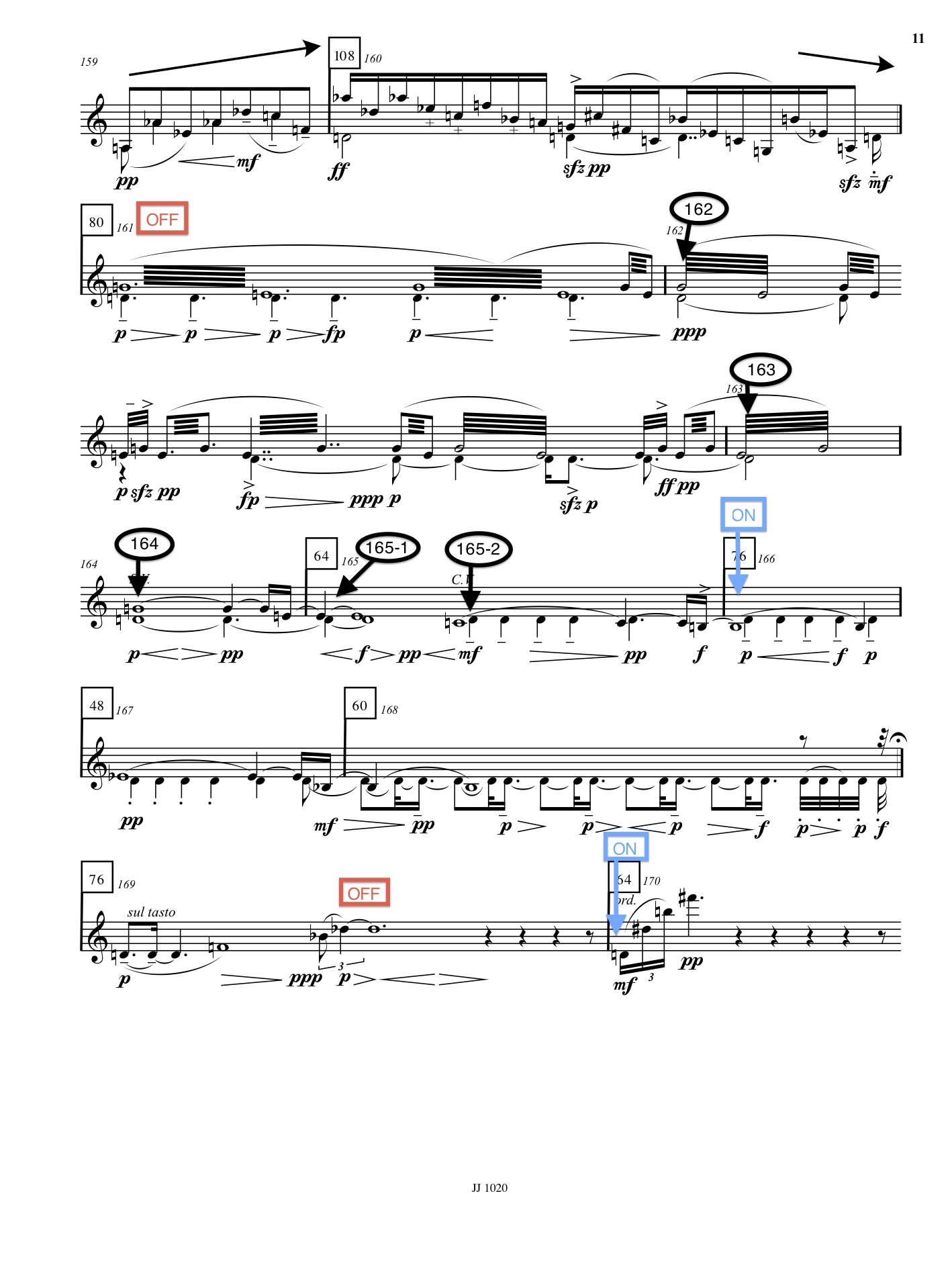
© IRCAM

This documentation is licensed under a Creative Commons Attribution-NonCommercial-NoDerivatives 4.0 International License.
Program note
_Einspielung I_ est dédiée à ma fille Martha. _Einspielung_, mot assez peu usité en allemand, a diverses acceptions. La première indique « une allusion à … » La seconde est plus spécifique à la musique et surtout à la musique électronique : _Einspielband_ est en effet le nom qu’on donne à la bande électronique qui sera jouée en même temps qu’un orchestre, par exemple. Enfin, dans sa forme réflexive, le verbe _sich einspielen_ signifie « s’échauffer avant de jouer » : quelqu’un qui va jouer d’un instrument, ou sur une scène de théâtre, doit s’échauffer. Mais cet échauffement n’est pas un exercice purement mécanique et gratuit, séparé de l’intention : il s’agit de s’échauffer dans l’intention de jouer immédiatement après. C’est la première des trois _Einspielungen_. C’est aussi ma première pièce destinée à un instrument _polyphonique_ qui ne soit pas le piano. Celui-ci mis à part, je m’étais auparavant toujours refusé à écrire une pièce solo. J’ai toujours pensé, en effet, qu’il fallait arriver, dans une œuvre pour instrument seul, à une certaine thématisation du matériau, et ne pas se limiter à une simple succession de notes, si sophistiquée soit-elle. Dans mon idée, le solo devait présenter de nombreux recouvrements motiviques pour une cohérence musicale qui dépasserait la simple chronologie du déroulement. Si vous comparez les déroulements globaux des trois _Einspielungen_, on constate qu’ils sont très différents les uns des autres. J’avais, au départ, l’intention d’écrire neuf _Einspielungen_, avec trois types de pièces de facture très différente, se déclinant pour chacun des trois instruments considérés : violon, alto et violoncelle. Il devait donc y avoir une deuxième pièce pour violon, à la manière d’[work:10848][Einspielung II], et une troisième, à la manière d’[work:10849][Einspielung III], et ainsi de suite – mais j’ai changé d’avis et n’ai écrit qu’une pièce de chaque groupe. Celle pour violoncelle (_Einspielung II_) est sans doute la plus labyrinthique et donc, du point de vue de la perception, la plus cryptique – et la moins évidente. La pièce pour alto (_Einspielung III_) est moins articulée dans sa forme que celle pour violon et, du point de vue mélodique, beaucoup plus élancée – la _lancée_ mélodique y est plus vaste. La pièce pour violon est plus resserrée, plus encadrée d’une partie à une autre. Son découpage est beaucoup plus net, ce qui lui confère une forte prégnance mélodique et formelle.Emmanuel Nunes, festival Agora 2011.
Version documentation creation date: 9 juin 2021 09:41, update date: 7 septembre 2022 14:41